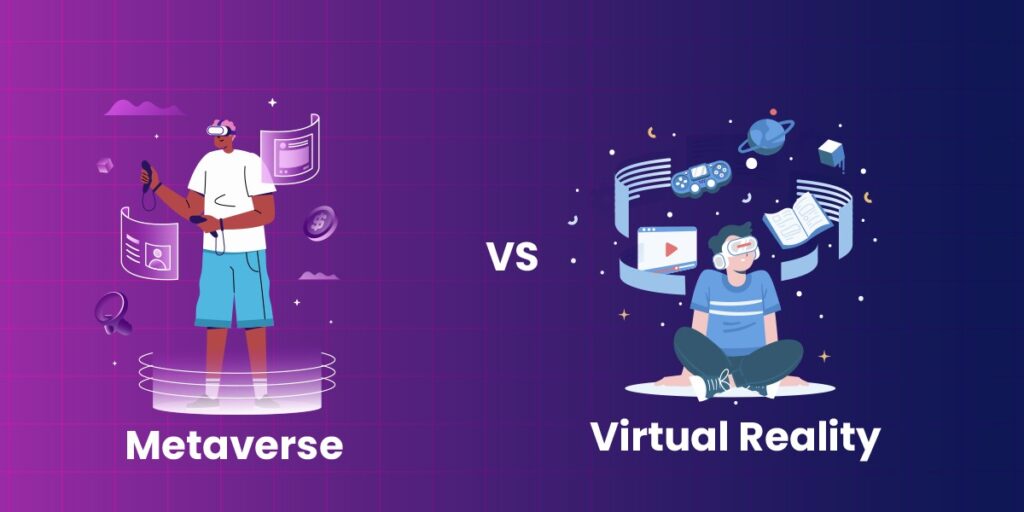Our interaction with the digital world changes with improvement in technology. The metaverse and virtual reality (VR) are two concepts that best illustrate this change. Although commonly used together, these concepts represent different but overlapping technologies. It is important to grasp these distinctions, especially as these technologies begin to permeate various sectors, including entertainment, business, and education. In this article, I explain what makes the metaverse and reality unique, their key differences, and future uses.
Explaining Virtual Reality
Virtual reality (VR) is a form of technology that enables the user to interact with an environment that has been simulated with a computer—this is called immersion. Users can interrelate with the virtual environment with the help of virtual reality devices, gloves, and other handheld controls. While wearing a VR headset like the Meta Quest 2 or HTC Vive, people’s actual surroundings are blocked off, revealing the virtual world. You can be fully immersed in a rainforest or pilot an interactive spacecraft. That is the power of VR experiences.
VR is highly effective in replicating the surroundings of a game, training exercise, or even an experiment. Whether you are playing a virtual reality game, taking part in a medical training simulation, or sitting at a conference, there is one thing in common, and that is entering into a virtual realm far disconnected from the physical world. Surprisingly, these realms exist autonomously and do not network with other developing digital technologies.
Exploring The Metaverse
The metaverse is a multifaceted phenomenon that depicts a virtual universe where users can engage with one another in real time from numerous interconnected digital spaces. The metaverse is exactly similar to the World Wide Web, but instead of going through web pages, you get to visit digital realms. Just consider it as a collective, unceasing metaverse that can be accessed through the Internet where people can possess properties, interact socially, work, shop, and play.
The metaverse is all-encompassing and untethered—meaning it is created and experienced on different devices and platforms with the help of augmented reality (AR), artificial intelligence, and blockchain. Unlike virtual reality applications that only have a limited part within the Metaverse, the latter approaches are broader, including these mixed reality applications, powered virtual economies, and user-identical avatars existing in the frame virtual-scope ecosystem.
An example of a growing platform in the metaverse is Decentraland, a virtual world where users can purchase digital land, engage with other users, and participate in various events, all while maintaining the continuity of the metaverse in real life.
Differences in Scope Between the Metaverse and Virtual Reality
One notable difference between VR and the metaverse is the scope, definition, and purpose of the two. Virtual reality is device dependent because it requires a VR headset. It also revolves around a single person looking for a deeply immersive experience. The metaverse, however, does not depend on a single device or platform; instead, it functions as a decentralized ecosystem that is intended to be a collective network that integrates diverse users, companies, and other platforms.
While the metaverse and VR differ in scope, the metaverse integrates a variety of social elements, while VR is mostly bounded to the simulation of existing environments. An example would be how VR is able to imitate flight training. The metaverse allows users to create virtual rooms in collaboration with others in real time.
Archaic dependence on technology explains VR; the metaverse takes a new approach by integrating daily real-life activities with digital interactions of the users. Each has its high points, in which they differ most, in the use and level of social engagement.
The User Experience: Metaverse vs. VR
User experience serves as one of the main differentiators of the metaverse and VR. With respect to VR experiences, users have the ability to interact with a specific environment, such as fighting zombies or examining ruins, but they are normally non-interactive at some level beyond the game or other activity (the user level). At some point, the users disengage from the experience and return back to reality.
But with the metaverse, there is a greater feeling of continuity or a driving reason for usage. It permits the use of customized avatars, ownership of real estate, social virtual meetings, and even social interactions with various entities. The experience is multifaceted and remains unchanged no matter if you try to log out. No matter whether you log off, your digital assets, conversations, and activities remain.
When it comes to passive entertainment and experiences, it is difficult to ignore the immersive environment offered by VR. Whereas, for users looking for a second life and more involvement and interaction, the metaverse offers limitless opportunities.
Applications of Metaverse and Virtual Reality
Regardless of their particularities, both the VR and the metaverse models have shown to have a wide scope of application in different fields.
Applications of Virtual Reality
The most notable parts of VR are found in gaming, healthcare, and training. Users are entertained by the immersion of popular VR games like “Beat Saber.” Simultaneously, healthcare provides training exercises that let surgeons practice in virtual operating rooms. Real estate agents can give prospective clients virtual tours of properties, as businesses are now using VR for marketing purposes.
Uses of the Metaverse
The metaverse is changing the landscape of human interaction and work-life balance. The use of virtual meetings on platforms such as Horizon Workrooms is increasingly common with remote work. Users can shop online as retailers are developing virtual shops. Fortnite even hosts virtual concerts, which change the face of entertainment. Furthermore, the metaverse is supported by blockchain technology to create an economy that allows users to buy, sell, or even trade digital art, fashion, real estate, or even clothes.
The Future of Metaverse and Virtual Reality
There will surely be drastic changes to VR and the metaverse in the form of new technologies, products, and services, which will drastically change the masses’ perspective on these elements. It is highly likely that VR will improve in the form of cheaper headsets with lower weight combined with better graphics display technologies. Advancements like this would heavily benefit the educational sector and the military by providing more real-feel and impactful scenarios and simulations.
Even while the metaverse is still developing, it has the potential to become widely used as a centralized site for work, recreation, and socialization. The blending of different platforms through blockchain and the application of reality will be crucial in merging the different virtual worlds. Companies are anticipating where the metaverse might fit into their business models, expecting a time when efforts in collaborative work are totally virtual in nature.
Analysts believe that VR and the metaverse will complement each other instead of competing with each other. Both are constituents of the next phase of the constantly changing technology advancement cycle.
Conclusion
Differences in VR and in the metaverse allow for a delineation that assists individuals and companies planning the adoption and deployment of these technologies. While gaming fans or people wishing to have total control over an experience, VR is ideally suited for them. If the intention is artistic creation or socializing with a much wider audience, then the metaverse is a platform to settle on. Both are innovations in technology, each in its distinct way, but all have one aim, which is to change human interaction beyond imagination.
FAQs
1. What is the main difference between virtual reality and the metaverse?
Virtual embraced reality is an experience encapsulated with devices that immerse you in a set environment, while the metaverse is a vast multi-platform ecosystem having virtual spaces that can be accessed endlessly.
2. Can virtual reality be part of the metaverse?
Indeed, VR can be utilized as one of several access points into the Metaverse, as it can offer experiences within shared virtual spaces.
3. Do you need a VR headset to access the metaverse?
No, the metaverse can be accessed through devices other than VR headsets. These devices include AR devices, mobile phones, and computers.
4. How do businesses make use of the metaverse?
Companies are employing the metaverse in hosting virtual events, collaborative working environments, virtual shops, and for greater customer service.
5. Which is better for gaming—virtual reality or the metaverse?
It depends on what experience you prefer to have. Immersive VR is ideal for highly engaging and physical gaming, while the metaverse is ideal for fans of multiplayer interactivity and community gaming.

